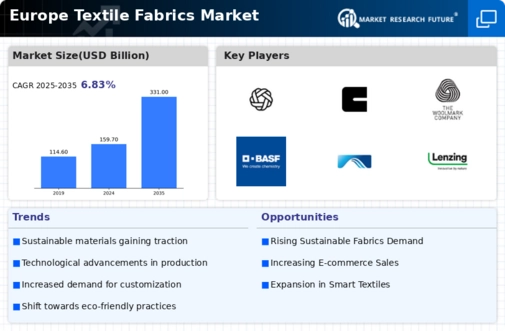The Europe Textile Fabrics Market is characterized by a complex interplay of multiple players who vie for market share while adapting to evolving consumer preferences and regulatory environments. The competitive landscape is marked by a mix of established companies and emerging players, with a focus on sustainability, innovation, and technology. The demand for high-quality, eco-friendly textile fabrics is on the rise, prompting companies to enhance their product offerings and streamline their supply chains.
Additionally, the market experiences fluctuated based on global economic factors, raw material availability, and technological advancements, which influence pricing strategies and product development initiatives. Participants are increasingly engaging in strategic collaborations, mergers, and acquisitions to enhance their market positioning and operational capabilities, thereby reshaping the competitive dynamics within the sector.Textile Exchange stands out in the Europe Textile Fabrics Market for its commitment to sustainability and innovative practices. This organization primarily works to promote the advancement of the global textile industry by providing resources, best practices, and a platform for collaboration among stakeholders.
The strength of Textile Exchange lies in its focus on driving sustainability throughout the textile fabric lifecycle. By establishing a common framework for sustainable practices, such as organic cotton and recycled fibers, Textile Exchange facilitates a significant transformation in fabric sourcing, ensuring that more companies can access sustainably sourced materials. Additionally, the presence of a well-established network of members contributes to its leading position in advocating for a shift toward eco-friendly practices in the European textile sector.Clariant plays a pivotal role in the Europe Textile Fabrics Market, renowned for its specialty chemicals and innovative solutions for textile manufacturing.
With a strong market presence across various segments, Clariant's key products encompass colorants, additives, and functional chemicals tailored specifically for textiles. The company's strength lies in its dedication to research and development, which enables it to deliver customized solutions to meet the diverse needs of its clients. Clariant has also pursued strategic mergers and acquisitions that bolster its product portfolio and enhance its market reach within Europe, allowing it to respond effectively to emerging trends and demands.
By emphasizing sustainability, Clariant focuses on producing environmentally friendly textile solutions that align with global efforts to reduce environmental impacts, positioning itself as a forward-thinking leader in the European textiles market.






















Leave a Comment